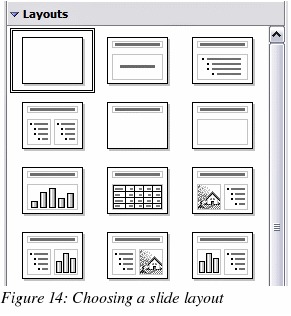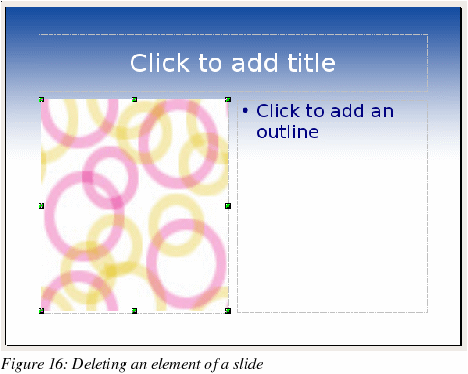Formatting a presentation
Now
put your presentation together based on your outline.
|
Caution

|
Remember
to save frequently while working on the
presentation, to prevent any loss of
information should something unexpected occur. You
might also want to activate the AutoRecovery
function
(Tools > Options > Load/Save >
General). Make
sure Save
AutoRecovery information every
is selected and that you have entered a recovery frequency.
|
Creating
the first slide
The
first slide is normally a title slide. Decide which of the layouts
will best suit your purposes for this first slide: simplicity would
be appropriate in this instance. You can use the pre-packaged
layouts available in the Layout section of the Tasks
pane. Suitable layouts are Title
Slide (which also contains a section for a
subtitle) or Title
Only, however all but one layout (the blank one)
contains a title section, so you are not restricted to the two
layouts described here.
|
Tip
|
If
you do not know the names for the pre-packaged layouts, you can
use the tooltip feature. Position the cursor on an icon in the
Layout section (or on any toolbar icon) and its name will be
displayed in a small rectangle.
If
the tooltips are not enabled, you can enable them. From the main
menu, select Tools
> Options > OpenOffice.org > General > Help
and mark the Tips
checkbox. If the Extended
tips checkbox is
also marked, you will get more detailed tooltip information, but
the tooltip names themselves will not be provided.
|
Select
a layout in the Layout section of the Tasks pane by clicking on it:
it appears in the Workspace. To create the title, click on “Click
to add title” (assuming the Blank
Slide layout was not used)
and then type
the title text. Adjustments to the formatting of the title can be
done by pressing the F11
key, right-clicking the Title
presentation style
entry, and selecting Modify
from the pop-up menu.
If
you are using the
Title
Slide layout,
click on “Click
to add text” to add a subtitle.
Proceed as above to make adjustments to the formatting if required.
Inserting
additional slides
The
steps for inserting additional slides are basically the same as for
selecting the title page. It is a process that has to be repeated
for each slide. Unless you are using more than one slide master,
your only concern is the Layouts
section of the Tasks pane
(Figure 14).

First
insert all the slides your outline indicates you will need. Only
after this should you begin adding special effects such as custom
animation and slide transitions.
Step
1: Insert a new
slide. This can be done in a variety of ways—take
your pick.
Insert
> Slide.
Right-click
on the present slide, and select Slide
> New Slide from
the pop-up menu.
Click
the Slide
icon in the Presentation
toolbar (Figure 15).

Step
2: Select the layout
slide that bests fits your needs.
Step
3: Modify the
elements of the slide. At this stage, the slide consists of
everything contained in the slide master, as well as the chosen
layout slide, so this includes removing unneeded elements, adding
needed elements (such as pictures), and inserting text.
|
Caution

|
Changes
to any of the pre-packaged layouts can only be made using View >
Normal, which is
the default. Attempting to do this by modifying a slide master
may result in unpredictable results and requires extra care as
well as some trials and errors.
|
Remove
any element on the slide that is not required (Figure 16).
Click
the element to highlight it. (The green squares show it is
highlighted.)
Press the Delete
key to remove it.

|
Tip
|
Sometimes
you will accidentally select the wrong layout slide or decide to
change it. This is safe and does not cause loss of the contents
already on the slide.
|
Add
any elements to the slide that you do need.
Adding
pictures to the clipart frame, if your chosen layout includes one:
Double-click
the picture within the frame. The Insert picture dialog opens.
Browse
to the location of the picture you want to include. To see a
preview of the picture, check Preview at the bottom of the
Insert picture dialog.
Select
the picture and click Open.
Resize
the picture as necessary. Follow the directions in the Caution
note below.
Adding pictures from graphic
files to places other than the clipart frame:
Insert
> Picture > From File.
The Insert picture dialog opens.
Browse
to the graphic file. To see a preview of the picture, check
Preview at the bottom of the Insert picture dialog. Select
a pciture and click Open.
Move
the picture to its location.
Resize
the picture, if necessary.
Adding OLE Objects is an
advanced technique covered in Chapter 7 (Inserting spreadsheets,
charts, and objects).
|
Caution

|
When
resizing a graphic, right-click the picture. Select Position
and Size from
the context menu and make sure that Keep
ratio is
selected. Then adjust the height or width to the size you need.
(As you adjust one dimension both dimensions will change.)
Failure to do so will cause the picture to become distorted.
Remember also that resizing a bitmap image will reduce its
quality; better by far to create an image of the desired size
outside of Impress.
|
Adding
text to a slide: If the slide contains text, click on “Click
to add an outline” in the text frame
and then type your text. The Outline styles from 1 to 10 are
automatically applied to the text as you insert it. You can change
the outline level of each paragraph as well as its position within
the text using the arrow buttons on the Text
Formatting
toolbar (see the section Outline view on page 5).
Step
4: To create
additional slides, repeat steps 1–3.
Modifying
the appearance of slides
To
change the background and other characteristics of all slides in the
presentation, you need to modify the slide master or choose a
different slide master.
A
Slide
Master is a slide with a specified set of
characteristics which is used as the beginning point for creating
other slides. These characteristics include the background, objects
in the background, formatting of any text used, and any background
graphics.
|
Note
|
OOo
uses three interchangeable terms for this one concept. Master
slide,
slide
master, and
master
page all
refer to a slide that is used to create other slides. This book,
however, will use only the term slide
master,
except when describing the user interface.
|
Impress
has five pre-packaged slide masters, found in the Master Pages
section of the Tasks
pane (Figure 3). You can also create and save
additional slide masters. See Chapter 2 for information on creating
and modifying slide masters.
Modifying
the slide show
Now
review the entire presentation and answer some questions. Run the
slide show at least once before answering them. You might want to
add some questions of your own.
Are the slides in the
correct order? If not, some of them will need to be moved.
Would an additional slide make
a particular point clearer? If so, another slide needs to be
created.
Would some custom animations
help some of the slides? (Advanced technique.)
Should some of the slides have
a different slide transition than others? The transition of those
slides should be changed.
Do some of the slides seem
unnecessary? Delete the affected slide or slides after checking if
they are indeed unnecessary.
|
Caution

|
If
one or more slides seems to be unnecessary, hide the slide or
slides, and view the slide show a few more times to make sure. To
hide a slide, right-click the slide in the Slides pane. Select
Hide Slide
in the pop-up menu. Do not delete a slide until you have done
this, otherwise you may have to create that slide again.
|
Once
you have answered these and your own questions, you should make the
necessary changes. This is done most easily in the Slide Sorter view
(see page 8). If you need one or more new slides, create them using
the steps listed in “Inserting additional slides” on page 17.
Renaming
slides
Right-click
on a thumbnail in the Slides pane or the Slide Sorter and choose
Rename Slide from
the pop-up menu. In the Name
field, delete the old name of the slide and type the new name. Click
OK to save the
change.
Custom
animations
If
you know how to add a custom animation to a slide and wish to do so,
do it now. Custom animations are found on the Tasks pane. This is an
advanced technique and is explained in Chapter 9 (Slide shows).
Slide
transitions
Your
first slide show should probably have the same slide transition for
all slides. Setting Advance
slide to On
mouse click is the
default and a simple setting. If you want each slide to be shown for
a specific amount of time, click Automatically
after and enter the
number of seconds. Click Apply
to all slides.
Transition
choices are found on the Tasks pane. For more information about
slide transitions, see Chapter 9 (Slide Shows).
|
Tip
|
The
Slide transition section has a very useful choice: Automatic
preview.
Select its checkbox. Then when you make any changes in a slide
transition, the new slide is previewed in the Slide Design area,
including its transition effect.
|
